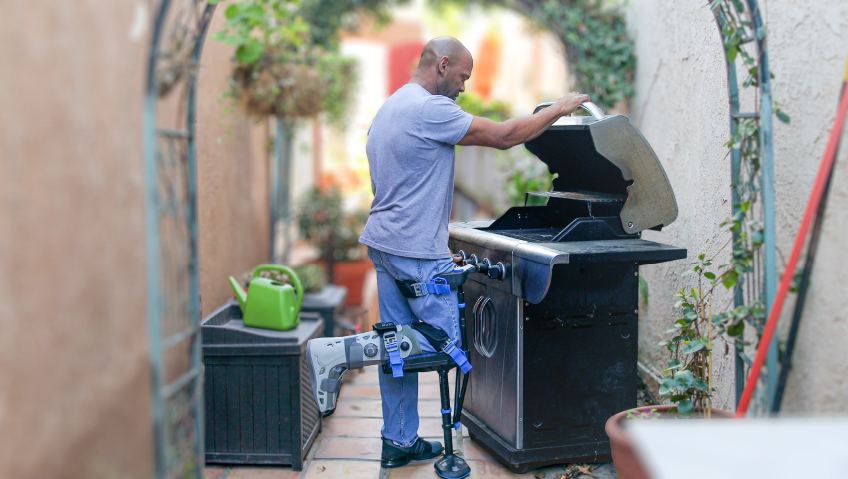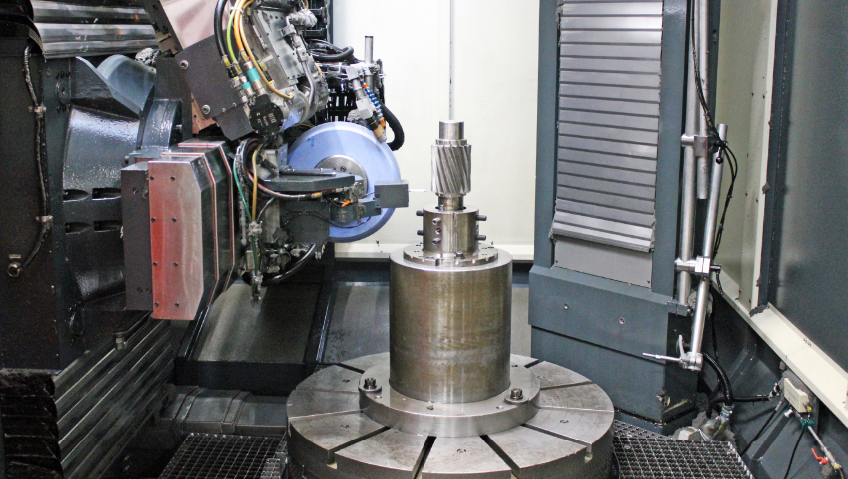“Once you’ve seen the iWALK hands-free crutch, you can’t unsee it,” says iWALKFree President Brad Hunter.
The FDA-registered iWALKFree crutch provides unmatched mobility and freedom from the constraints of traditional crutches for those with non-weight-bearing lower leg injuries including sprained or broken feet or ankles, Achilles injuries, lower limb amputations, and other below the knee conditions. iWALK is the only crutch substitute offering a degree of mobility that allows users to carry out daily tasks, heal faster, and regain freedom.
This painless, affordable, and straightforward device is making waves in the medical community as more and more studies reveal its unique ability to expedite healing while mimicking the muscle actions of a normal unassisted gait.
“We’re constantly changing and evolving our design to make it work better,” says Hunter. “We have a staff of people dedicated specifically to improving the product.”
While version 3.0 is currently on the market, version 4.0 is already in prototyping. And before 4.0 goes into production, 5.0 will be in design.
New technology
Even though the company strives to make each version perfect, consumers continually provide feedback and suggestions for improvement.
“The problems we’re trying to solve on the newest generation of crutch are more refinements than actual issues,” Hunter says. “For any manufactured product, people have no concept of how difficult it is to make something that works every time and is defect-free.” He adds that when anything medical-related is at stake, it’s essential that everything works as it’s supposed to, which is why the company devotes so many resources to its total quality management system.
Consumers, although often proposing valuable suggestions for improvements, don’t always understand how challenging it is to make even minor changes to the product, for example, in the case of a request for a shock absorber. “Unfortunately, it would add a lot of complexity, cost, and weight for not enough benefit,” says Hunter. “When your heel strikes the ground, that’s when your leg and hips and body feel the most force. We wanted to dampen that, but a shock absorber wasn’t really feasible.”
Instead, the company found a clever way of incorporating shock absorption into the foot of the crutch, similar to that in the heel of a running shoe, that was both protective and cost-effective. It’s in prototyping and has been “extremely well received.”
To get to that point, the team built prototypes which had actual active suspension with pivots and dampeners to determine exactly what they needed to achieve and found a clever and economical way to do it.
Proven right
The company’s successful innovations are getting noticed, evident in the fact that numerous imitations are now coming on the market.
“There’s an old saying that knockoffs prove you’re doing something right. We’re not afraid of them, except that the hands-free crutch is a relatively new concept, and if people go for the cheap knockoffs, their functionality is terrible,” Hunter says. “That can ruin the reputation of the hands-free crutch concept in general. But they’re not a challenge for us at all. If anything, it’s authentication that we’re doing it right.”
Fortunately, the imitations aren’t a commercial threat as the companies involved aren’t putting effort and resources into the product as they don’t specialize in it.
Conversely, “We only do the hands-free crutch; it’s our total focus. We provide the resources, the R&D, the quality control, and we meet the regulatory requirements. We also have technical support and customer service for iWALK customers. We have replacement parts, warranty, everything,” Hunter explains.
There is also the challenge of marketing, however, as potential users looking for crutches may not know the iWALK exists. “But because we’re the best-selling crutch on Amazon, they discover us when searching for conventional crutches,” Hunter says. “Online sales are good for us, because, again, people aren’t typically looking for an iWALK, they’re looking for something else. We’re still unfortunately at that stage of awareness.”
However, more and more doctors are recommending the device as they become familiar with its benefits, due in part to the copious amount of clinical research that’s been published. “For doctors, nothing is real unless it has the white paper to back it up,” Hunter says. “We have independent, peer-reviewed clinical research that is published in medical journals. And that’s the currency that doctors need to feel comfortable and know that the iWALK is legit.”
Better healing
The studies have shown that the medical benefits of the iWALK are numerous. “When the research came out, it validated what we already thought, but then actually turned out to be even better than that,” Hunter shares.
One of the studies included an electro-myocardiogram (EMG), where sensors are placed on the body to reveal muscle activity at the location of the sensor. “They ‘sensored up’ somebody’s leg walking normally,” Hunter says, “and then put sensors on the same leg walking with an iWALK. And the researchers were blown away.”
The study showed that with an iWALK, the muscles from the hip to the knee were doing the same thing as in a normal human walking action, but not only were the muscles of the upper leg active, so were those in the lower leg. Why is that important? It means significant reduction of the muscle atrophy that typically accompanies immobilized limbs. So although the affected leg has become non-weight-bearing, it has retained more muscle mass and your recovery will be quicker. “But even more significant is blood flow,” says Hunter. “And this is what’s mind-blowing.”
In simple terms, the heart pushes the blood out to the rest of the body with the furthest point being the lower leg. But the blood pressure from the heart pumping is not what brings blood back to the heart—what’s needed for that is muscle activity. The heart pushes blood out through the arteries and when the muscles contract, they push the blood back upstream through the veins to recirculate through the heart.
“If that muscle is dormant and has no activity, such as if using conventional crutches or knee scooters, then the venous pump—what this mechanism is called—is not activated. Essentially there’s a dam and the blood is blocked from flowing back upstream,” Hunter explains.
The most common place for this to happen is the lower leg. With no muscle activity, blood in the lower leg can pool, and nutrient- and oxygen-rich healing blood isn’t getting to the trauma site, meaning slower recovery.
“This can also lead to a blood clot called a DVT—deep vein thrombosis—and that’s nothing to fool with,” Hunter notes. It’s a serious, potentially deadly condition which is much more prevalent in people with non-weight-bearing lower-limb injuries due to lack of muscle activity. Ultimately, if you’re using crutches or a scooter, you run a higher risk of having a DVT than if you’re using an iWALK,” he says.
“It’s a lot to wrap your head around,” Hunter says, “but physicians understand it and fortunately, the research proves it. If there’s muscle activity, there’s venous pump activity. We all understand that muscle activity infers better blood flow, but because blood flow itself was not directly researched in the EMG studies, we didn’t actually prove the blood flow claim initially,” Hunter says. “So additional studies were conducted which specifically tested blood flow and researchers found that blood flow using an iWALK is substantially similar to normal unassisted human walking when you’re using not using a mobility device. And that’s huge.”
These studies also included surveys finding that fully 90 percent of people who use the iWALK, when given the choice between iWALK, conventional crutches, or a knee scooter, choose the iWALK. “Our primary problem is awareness and understanding. Awareness that this device exists and understanding of what it is, what it isn’t, and what it will do for you.”
Challenging the crutch paradigm
The company says that the biggest challenge it faces is changing a paradigm of thought.
“People have been using crutches for thousands of years and scooters now for 20 or 30 years. It’s just difficult to go against the mainstream, and it takes a lot of time.” But more and more people are saying their physician referred the iWALK to them, and more and more doctors are requesting brochures to hand out to their patients.
“So we’re winning, but we haven’t won yet,” Hunter says. “The biggest challenge, once again, is building a mainstream awareness of the device.”
Getting to the point of recognition and acceptance—as with knee scooters—is vital, he adds. “Because the device is so much better, the demand and the medical benefits are there. Our biggest challenge is educating everybody, including the physicians. We focus on the general consumer but also physicians because most people with a non-weight-bearing injury will go to a physician at some point. As a smaller company, we have a huge marketing challenge in building universal awareness of a new technology.”
Another challenge on a smaller scale is misconceptions. Because this is a new device and people have preconceived notions regarding blood flow and stability, ultimately, it’s the physicians who will have to provide sound medical advice.
“We identified a researcher who was the foremost expert in the field of angular momentum, which is the accepted way of measuring stability, and—surprise, surprise—the iWALK turns out to be way more stable than crutches, so it’s actually safer.” This debunks a common preconception that the iWALK might not be as stable as other mobility devices.
Quality systems
As iWALK has gained traction in the medical community and the company has grown, Hunter noticed the need for robust quality systems, both proactive and reactive, to be in place.
“I think we’ve done a particularly good job in that area, and this relates to the knockoffs of the iWALK. There’s no way they have the kind of quality control systems, with the documentation, that we have in place. You wouldn’t think this simple little device would have so much backing, but it does.”
The company also attends and exhibits at medical conferences, but right now its best salesperson is the customer who does a follow-up visit to their doctor and tells them how much they love the product.
“That’s still our most common referral source,” Hunter says. Social media is another excellent source of promotion where unbiased users in real-life situations share their experiences, photos, and videos.
“There’s so much user-generated content about the iWALK out there that’s building awareness organically,” he says. “And every endorsement and testimonial we’ve ever had was free, including 11 world champion athletes, gold medalists, and a list of celebrities including Harrison Ford. They may not know the medical benefits, but it’s all genuine.”
Tipping point
What the company is looking for is the proverbial tipping point of awareness, he adds. Scooters, for instance, weren’t advertised much, but the more people saw them “in the wild,” the more they started asking for them. “Ultimately, we want everyone to understand that this exists. Once that’s done, everything else will take care of itself.”
Hunter is convinced that as awareness and understanding of the benefits of the iWALK become more universal, the iWALK will become the first choice of mobility device, both by physicians and end users. “Once the medical community understands how significant the medical benefits are that this $150 device provides, one could argue that not having the iWALK as their primary recommendation subjects the qualified patient to preventable risk.”






